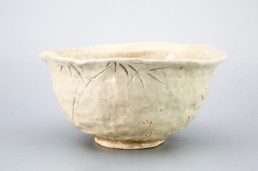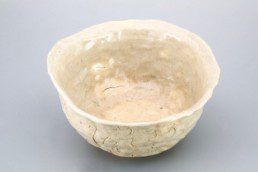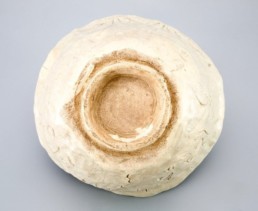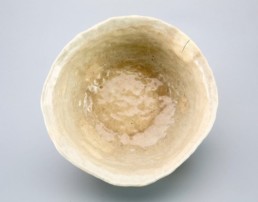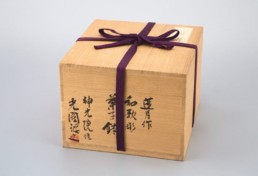Ōtagaki Rengetsu Kashibachi Dish (Exhibited/ Published)
Artist:Ōtagaki RengetsuEra:EdoPrice:SoldInquire:info@shirakuragallery.com
This rare and interesting ceramic work was done by one of the most renowned and loved waka poets of the 19th century, Ōtagaki Rengetsu (1791-1875). In fact, if you look closely at the attached images, you will see her finger imprints clearly preserved in the molded clay.
Born into a Samurai family but soon after adopted by the Ōtagaki family, from the age of seven to sixteen Rengetsu was a lady in waiting at Kameoka castle where she was trained in the arts and courtly graces. Due to her rumored great beauty, she soon married but after the death of her husband in 1823, she joined the temple Chion-in and became a nun, taking Rengetsu (Lotus Moon) as her Buddhist name.
Rengetsu is widely regarded as one of the greatest waka poets of the 19th century. A skilled Shijo School painter, she was also an accomplished calligrapher and potter. She admired and studied under a number of great poets including Ozawa Roan and Ueda Akinari, and later in life became a close friend and mentor to the artist Tomioka Tessai.
The poem reads:
Kono kimi wa, medetaki fushi wo, kasane tsutsu, sue no yo nagaki, tameshi nari keri
Our young bamboo, piling up happy knots, year upon year, tips reaching high, an inspiration to us.
Bamboo is an important symbol in Japan that signifies strength and resilience. For those familiar with the details of Rengetsu’s life, they will immediately understand why this is a very fitting image to associate with her memory. Though she endured great suffering and faced many trials during her lifetime, some say that this is what helped instill her artworks with a gentle dignity and grace which few others have matched.
With a diameter of 8.3 inches (21 cm) and standing 4.3 inches tall (11 cm), this work was prominently featured in a 2014 exhibition at the Nomura Art Museum in Kyoto, Japan (one of the largest exhibitions of the works of Rengetsu to date). It can be seen on page 84 of the associated museum catalog—Ōtagaki Rengetsu: Poetry and Artwork from a Rustic Hut, 2014. One of the larger ceramic pieces remaining from her body of work, this kashibachi (sweets dish) comes with a very detailed certificate box notarized by Koen—a priest of Jinko-in (where Rengetsu spent the greater part of her later years).
Additional Resources:
https://en.wikipedia.org/wiki/Ōtagaki_Rengetsu
https://www.metmuseum.org/art/collection/search/816262
